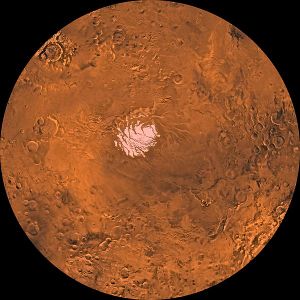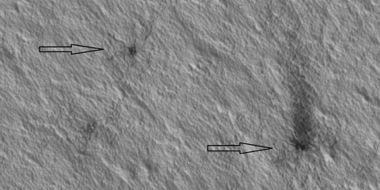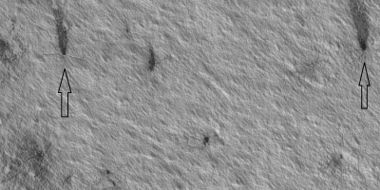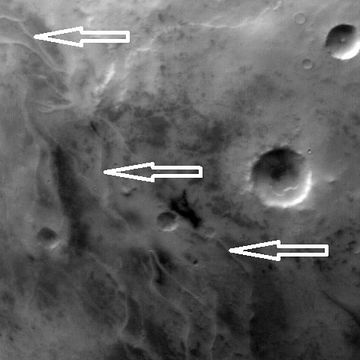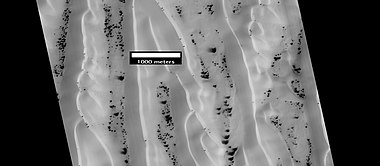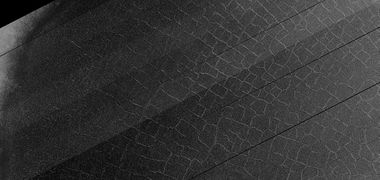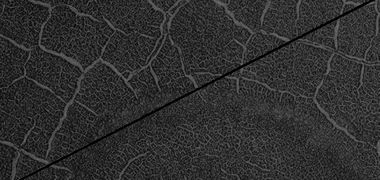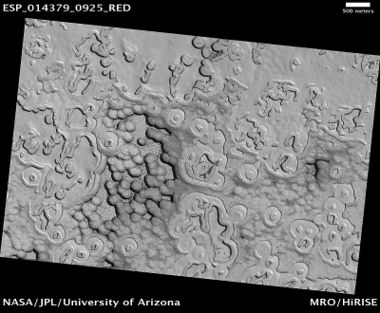Difference between revisions of "Mare Australe quadrangle"
m |
m (→Craters) |
||
| Line 148: | Line 148: | ||
<gallery class="center" widths="380px" heights="360px"> | <gallery class="center" widths="380px" heights="360px"> | ||
Image:Close-up of McMurdo Crater Layers.JPG|Close-up of Layers in wall of McMurdo Crater, as seen by HiRISE. | Image:Close-up of McMurdo Crater Layers.JPG|Close-up of Layers in wall of McMurdo Crater, as seen by HiRISE. | ||
| − | |||
| − | |||
| − | |||
| − | |||
| − | |||
Revision as of 13:09, 13 March 2020
| MC-30 | Mare Australe | 65–90° S | 180° W – 180° E | Quadrangles | Atlas |
Mare Australe is the south pole of Mars.
The region around the South Pole in the Mare Australe quadrangle is chuck full of unusual features that are created by bewildering processes. And they have been given equally odd names: spiders, Swiss-cheese terrain, dust devils, and polygons. During certain seasons, geysers of dust blow out of the ground and go hundreds of feet into the air. At another season, giant dust devils move over the landscape. Much of the environs is full of things related to dry ice changing into a gas. Indeed, this process makes measurable changes in the gravity of the planet. Life may now exist in a giant liquid lake under the ice cap.
The Mare Australe quadrangle is one of a series of 30 quadrangle maps of Mars used by the United States Geological Survey (USGS). The Mare Australe quadrangle is also referred to as MC-30 (Mars Chart-30).[1] The quadrangle covers all the area of Mars south of 65°. The quadrangle's name derives from an older name for a feature that is now called Planum Australe, a large plain surrounding the polar cap.[2] The Mars polar lander]crash landed in this region.[3] [4]
Contents
- 1 Notable features
- 2 Freezing of atmosphere
- 3 Lake of liquid water
- 4 Spiders
- 5 South polar cap
- 6 Dorsa Argentea Formation
- 7 Defrosting
- 8 Dust devil tracks
- 9 Gullies
- 10 Craters
- 11 Craters showing defrosting in spring
- 12 Polygons
- 13 Swiss Cheese Terrain
- 14 Layers
- 15 Other features in Mare Australe quadrangle
- 16 See also
- 17 References
Notable features
The region includes the South Polar ice cap. The central part is mainly a permanent residual ice cap surrounded by layered and troughed terrain which is, in turn, encircled by heavily cratered terrain. Around the southern ice cap is a surface, called the Dorsa Argentea Formation that may be an old ice-rich deposit. It contains a group of sinuous, branched ridges that resembles eskers that form when streams are under glaciers.[5] The formation often contains pits: two major locations are named Cavi Angusti and Cavi Sisyphi. The pits have steep sides and an irregular shape. They are up to 50 km across and 1 km deep.[6] The quadrangle also contains “Angustus Labyrinthus”, a formation of intersecting valley or ridges, nicknamed the "Inca City". Its straight and box-like shapes looks like the remains of an old city.[7] Researchers were surprised to see parts of the surface having a Swiss-cheese appearance. Also, some areas showed strange spider-shaped forms, which were determined to be caused by carbon dioxide gas blowing dust around at certain times of the year. Some craters in Mare Australe show gullies. Martian gullies are small, incised networks of narrow channels and their associated downslope sediment deposits, found in certain locations on the Planet. They are named for their resemblance to terrestrial gullies. First discovered on images from Mars Global Surveyor, they occur on steep slopes, especially on the walls of craters. Usually, each gully has an alcove at its head, a fan-shaped apron at its base, and a channel linking the two, giving the whole gully an hourglass shape.[8] They are believed to be relatively young because they have few, if any craters. On the basis of their form, aspects, positions, and location amongst and apparent interaction with features thought to be rich in water ice, many researchers believed that the processes carving the gullies involve liquid water. However, this idea changed as more observations poured into NASA facilities. As soon as gullies were discovered, researchers began to image many gullies over and over, looking for possible changes. By 2006, some changes were found.[9] Later, with further analysis it was determined that the changes could have occurred by dry granular flows rather than being driven by flowing water.[10][11] [12] With continued observations many more changes were found in Gasa Crater and others.[13] It was discovered that since changes in gullies occur in the winter and spring. Consequently, experts now believe that gullies were formed from dry ice. Before-and-after images demonstrated the timing of this activity coincided with seasonal carbon-dioxide frost and temperatures that would not have allowed for liquid water. So, new gullies were produced just when dry ice started to thaw in the spring. The process would have been helped along by dry ice frost changing to a gas, thereby lifting and lubricating dry material on steep slopes.[14] [15][16] In some years frost, perhaps as thick as 1 meter accumulates during winter months.
Freezing of atmosphere
Research based on slight changes in the orbits of spacecraft around Mars over 16 years found that when one hemisphere experiences winter, approximately 3 trillion to 4 trillion tons of carbon dioxide freezes out of the atmosphere onto the northern and southern polar caps. This represents 12 to 16 percent of the mass of the entire Martian atmosphere. These observation support predictions from the Mars Global Reference Atmospheric Model—2010.[17] [18]
Lake of liquid water
Scientists reported in July 2018, the discovery of a lake of liquid water under the southern ice cap. The measurements were gathered with the Mars Advanced Radar for Subsurface and Ionosphere Sounding (MARSIS) on board the European Space Agency's orbiting Mars Express spacecraft. Radar reflections showed a bright spot in the ice layers that analysis later showed that it had to be a lake of liquid water. It is believed that the water remains liquid, even at the temperature of -68 degrees Celsius because there is likely much dissolved salt that lowers the freezing point. The lake is about 20 kilometers across and at least 10 centimeters deep. It could contain 10 billion liters of liquid water.[19] [20] There could very well be many small bodies of water under the ice cap; however, they are difficult to detect with MARSIS. Also, the raw date coverage needed for these detections is limited—only a few percent of the area has a full set of data. [21]
Spiders
Early on orbiting satellites saw strange features that looked like and were called “spiders.” After a number of years of observations, scientists finally came up with an explanation for these features. During the winter, much frost accumulates. It freezes out directly onto the surface of the permanent polar cap, which is made of water ice covered with layers of dust and sand. The deposit begins as a layer of dusty carbon dioxide frost. Over the winter, it recrystallizes and becomes denser. The dust and sand particles caught in the frost slowly sink. By the time temperatures rise in the spring, the frost layer has become a slab of semi-transparent ice about 3 feet thick, lying on a substrate of dark sand and dust. This dark material absorbs light and causes the ice to sublimate (turn directly into a gas) below the surface. Eventually much gas accumulates and becomes pressurized. When it finds a weak spot, the gas escapes and blows out the dust.[22] Speeds can reach 100 miles per hour.[23] Dark channels can sometimes be seen; they are called "spiders."[24] [25] [26] [27] [28] [29] The surface appears covered with dark spots when this process is occurring.[30] The official name for spiders is "araneiforms."[31] These features can be seen in some of the pictures below.
Close view of spider formations The polygon shapes are channels caused by pressurized carbon dioxide going through cracks. During the winter season, a slab of dry ice forms on the ground surface. The surface contains cracks in the shape of polygons. During certain times, CO2 under the ice becomes pressurized from sunlight penetrating the slab of dry ice. As the gas moves around the channels become larger.
Close view of spider formations, as seen by HiRISE under HiWish programm Polygon-shaped channels are also visible.
South polar cap
The south polar permanent cap is much smaller than the one in the north. It is 400 km in diameter, as compared to the 1100 km diameter of the northern cap.[32] Each southern winter, the ice cap covers the surface to a latitude of 50°.[33] Part of the ice cap consists of dry ice, solid carbon dioxide. Each winter the ice cap grows by adding 1.5 to 2 meters of dry ice from precipitation from a polar-hood of clouds. In summer, the dry ice sublimates (goes directly from a solid to a gas) into the atmosphere. During each year on Mars as much as a third of Mars' thin carbon dioxide (CO2) atmosphere "freezes out" during the winter in the northern and southern hemispheres. Scientists have even measured tiny changes in the gravity field of Mars due to the movement of carbon dioxide. In other words, the winter buildup of ice changes the gravity of the planet.[34] Mars has seasons that are similar to Earth's because its rotational axis has a tilt close to our own Earth's (25.19° for Mars, 23.45° for Earth). The south polar cap is higher in altitude and colder than the one in the north.[35]
The residual southern ice cap is displaced; that is, it is not centered on the South Pole. However, the south seasonal cap is centered near the geographic pole.[36] Studies have shown that the off center cap is caused by much more snow falling on one side than the other. In the end, the off center cap is due to the texture of the surface. On the western hemisphere side of the South Pole a low pressure system forms because the winds are changed by the Hellas Basin. This system produces more snow. On the other side, there is less snow and more frost. Snow tends to reflect more sunlight in the summer so not much melts or sublimates (Mars climate causes snow to go directly from a solid to a gas). Frost on the other hand has a rougher surface and tends to trap more sunlight, resulting in more sublimation. In other words, areas with more of the rougher frost are warmer.[37] Research, published in April 2011, described a large deposit of frozen carbon dioxide near the south pole. Most of this deposit probably enters Mars' atmosphere when the planet's tilt increases. When this occurs, the atmosphere thickens, winds get stronger, and larger areas on the surface can support liquid water.[38] This observation has great significance because if these deposits were all changed into gas, the atmospheric pressure on Mars would double.[39] There are three layers of these deposits; each is capped with a 30-meter layer of water ice that prevents the CO2 from sublimating into the atmosphere. In sublimation a solid material goes directly into a gas phase. These three layers are linked to periods when the atmosphere collapsed when the climate changed.[40]
Dorsa Argentea Formation
A large field of eskers exist around the south pole. Since eskers were once streams under glaciers or ice sheets, it is believed that the eskers are proof of a giant ice sheet. This formations is called the ‘Dorsa Argentea Formation.”[41] [42] [43] [44] < This large polar ice sheet is believed to have covered about 1.5 million square kilometers. That area is twice the area of the state of Texas.[45] This group of ridges extends from 270–100 E and 70–90 S, around the south pole of Mars. It sits under the Late Amazonian South Polar Layered Deposits (SPLD). The amount of these ridges is huge, one study studied seven different ridge systems which contained almost 4,000 ridges that had a total length 51,000 km.[46] Most eskers are thought to be formed inside ice-walled tunnels by streams which flowed within and under glaciers. After the retaining ice walls melted away, stream deposits remained as long winding ridges. A team of researchers used an early Mars global climate model together with the University of Maine Ice Sheet Model to determine how the eskers formed. They concluded that to get enough a high enough temperature in the Martian atmosphere to form the ice sheet, a greenhouse gas in addition to a thicker carbon dioxide atmosphere was needed to warm the surface near the poles by at least 20 degrees C. Also, to produce the shape of the ice sheet, at least part of the Tharsis volcanoes needed to be present.[47] [48] [49] [50] [51] [52] [53] [54] There may have been much more water available in the Martian atmosphere when the ice sheet developed.[55] A thick ice sheet was able to be formed more easily in the south polar region than in the North pole because the south pole is higher in altitude.
Defrosting
As the temperature warms and more sunlight becomes available in the spring, frost starts to disappear. This process begins with the appearance of dark spots. By the time the temperature rises to the melting point of water ice, all ice is gone. The process was first followed with repeated images by the Mars Global Surveyor.[56][57] With the much greater resolution of HiRISE, it was seen that many spots had the shape of fans. Some of these spots and fans are visible in the pictures below. Thousands of fans were examined by a Citizen Science project. Nearly all (96%) of the fans measured in this study have a length below 100m. The average fan length is at 33.1m. The three largest fans lengths of 373m, 368m and 361m and were all in the same region.[58]
Close view of defrosting, as seen by HiRISE under HiWish program Gas and dark dust is probably being blown out of ground and then carried by winds toward the Northwest.
Dust devil tracks
Many areas on Mars experience the passage of giant dust devils. A thin coating of fine bright dust covers most of the Martian surface. When a dust devil goes by it blows away the coating and exposes the underlying dark surface. Dust devils occur when the sun warms up the air near a flat, dry surface. The warm air then rises quickly through the cooler air and begins spinning while moving ahead. This spinning, moving cell may pick up dust and sand then leave behind a clean surface.[59] Dust devils have been seen from the ground and high overhead from orbit. They have even blown the dust off of the solar panels of the two Mars Exploration Rovers]], thereby greatly extending their lives.[60] The twin Rovers were designed to last for 3 months, instead they went for many years, and one was active for over 16 years. The pattern of the tracks have been shown to change every few months A study that combined data from the High Resolution Stereo Camera (HRSC) and the Mars Orbiter Camera (MOC) found that some large dust devils on Mars have a diameter of 700 meters and last at least 26 minutes.[61]
Weinbaum crater region showing dust devil tracks, as seen by CTX camera (on Mars Reconnaissance Orbiter)
Dust devil tracks in Mitchell crater, as seen by CTX camera (on Mars Reconnaissance Orbiter). Note: this is an enlargement of a previous image of west side of Mitchel crater.
Gullies
Gullies occur on steep slopes, especially on the walls of craters. Gullies are believed to be relatively young because they have few, if any craters. Moreover, they lie on top of sand dunes which themselves are considered to be quite young. Usually, each gully has an alcove, channel, and apron.[62]
Gullies that were thought to be caused by recent flowing water. However, with further extensive observations with HiRISE it was found that many are forming/changing today, even though liquid water cannot exist under current Martian conditions. Scientists came up with other ideas to explain them. The consensus seems to be that although water may have helped form them in the past, today they are being produced by chunks of dry ice moving down steep slopes. [63] [64] [65]
Craters
Many places on Mars show rocks arranged in layers. The study of layering on Mars greatly expanded when the Mars Global Surveyor sent back images.[66] [67] Rock can form layers in a variety of ways. Volcanoes, wind, or water can produce layers.[68] [69] [70] A detailed discussion of layering with many Martian examples can be found in Sedimentary Geology of Mars.[71] A paper by Grotzinger and Milliken discusses the role of water and wind in forming layers of sedimentary rocks.[72] Since craters are low spots on the landscape material can more easily accumulate there and may resist erosion longer than other places.
Craters showing defrosting in spring
Dust trails in Main crater, as seen by CTX camera (onMars Reconnaissance Orbiter). Arrow indicates wind direction. In the spring, as the temperature rises, dry ice turns into a pressurized gas, and then blows through a weak spot and carries with it dust. If there is a wind, the dust is deposited in an elongated form as in this image.
Polygons
Much of the surface of Mars shows the ground arranged into polygons of various sizes. Sometimes, during the right season the lows areas of polygons are full of frost. When this happens, the shapes are enhanced forming beautiful views.
Swiss Cheese Terrain
Parts of Mare Australe display pits that make the surface look like Swiss cheese.[73] [74] [75] [76] These pits are in a 1-10 meter thick layer of dry ice that is sitting on a much larger water ice cap. Pits have been observed to begin with small areas along faint fractures. The circular pits have steep walls that work to focus sunlight, thereby increasing erosion. For a pit to develop a steep wall of about 10 cm and a length of over 5 meters in necessary.[77]
Changes in South Pole surface from 1999 to 2001, as seen by Mars Global Surveyor.
Layers
Other features in Mare Australe quadrangle
See also
- Dark slope streaks
- Geography of Mars
- High Resolution Imaging Science Experiment (HiRISE)
- HiWish program
- How are features on Mars Named?
- Glaciers on Mars
- Layers on Mars
- Mars Global Surveyor
- Martian features that are signs of water ice
- Martian gullies
References
- ↑ Davies |first1= M.E. |last2= Batson |first2= R.M. |last3= Wu |first3= S.S.C. |chapter= Geodesy and Cartography |editor1-last= Kieffer |editor1-first= H.H. |editor2-last= Jakosky |editor2-first= B.M. |editor3-last= Snyder |editor3-first= C.W. |display-editors= 3 |editor4-last= Matthews |editor4-first= M.S. |title= Mars |publisher= University of Arizona Press |location= Tucson |date= 1992 |isbn= 978-0-8165-1257-7 |
- ↑ Patrick Moore and Robin Rees, ed. Patrick Moore's Data Book of Astronomy (Cambridge University Press, 2011), p. 130.
- ↑ http://mars.nasa.gov/msp98/lander/
- ↑ http://www.spaceref.com/news/viewnews.html?id=105
- ↑ Kargel |first1= J. |first2= R. |last2=Strom |date= 1991 |title= Terrestrial glacial eskers: analogs for martian sinuous ridges | journal= LPSC | volume=XXII | pages= 683–684 |
- ↑ Carr | first=Michael H. | publisher=Cambridge University Press | isbn= 978-0-521-87201-0 | title= The Surface of Mars |date=2006 |
- ↑ Hartmann, W. 2003. A Traveler's Guide to Mars. Workman Publishing. NY NY.
- ↑ Malin, M., Edgett, K. 2000. Evidence for recent groundwater seepage and surface runoff on Mars. Science 288, 2330–2335.
- ↑ Malin, M., K. Edgett, L. Posiolova, S. McColley, E. Dobrea. 2006. Present-day impact cratering rate and contemporary gully activity on Mars. Science 314, 1573_1577.
- ↑ Kolb, et al. 2010. Investigating gully flow emplacement mechanisms using apex slopes. Icarus 2008, 132-142.
- ↑ McEwen, A. et al. 2007. A closer look at water-related geological activity on Mars. Science 317, 1706-1708.
- ↑ Pelletier, J., et al. 2008. Recent bright gully deposits on Mars wet or dry flow? Geology 36, 211-214.
- ↑ NASA/Jet Propulsion Laboratory. "NASA orbiter finds new gully channel on Mars." ScienceDaily. ScienceDaily, 22 March 2014. www.sciencedaily.com/releases/2014/03/140322094409.htm
- ↑ http://www.jpl.nasa.gov/news/news.php?release=2014-226
- ↑ http://hirise.lpl.arizona.edu/ESP_032078_1420
- ↑ http://www.space.com/26534-mars-gullies-dry-ice.html
- ↑ NASA/Goddard Space Flight Center. "New gravity map gives best view yet inside Mars." ScienceDaily. ScienceDaily, 21 March 2016. <www.sciencedaily.com/releases/2016/03/160321154013.htm>.
- ↑ Antonio Genova, Sander Goossens, Frank G. Lemoine, Erwan Mazarico, Gregory A. Neumann, David E. Smith, Maria T. Zuber. Seasonal and static gravity field of Mars from MGS, Mars Odyssey and MRO radio science. Icarus, 2016; 272: 228 DOI: 10.1016/j.icarus.2016.02.05
- ↑ https://www.sciencenews.org/article/mars-may-have-lake-liquid-water-search-life
- ↑ R. Orosei et al. Radar evidence of subglacial liquid water on Mars. Science. Published online July 25, 2018. doi:10.1126/science.aar7268.
- ↑ R. Orosei et al. Radar evidence of subglacial liquid water on Mars. Science. Published online July 25, 2018. doi:10.1126/science.aar7268.
- ↑ http://spaceref.com/mars/how-gas-carves-channels-on-mars.html
- ↑ http://themis.asu.edu/news/gas-jets-spawn-dark-spiders-and-spots-mars-icecap
- ↑ http://mars.jpl.nasa.gov/multimedia/images/2016/possible-development-stages-of-martian-spiders
- ↑ http://spaceref.com/mars/growth-of-a-martian-trough-network.html
- ↑ Benson, M. 2012. Planetfall: New Solar System Visions
- ↑ http://www.astrobio.net/topic/solar-system/mars/spiders-invade-mars/
- ↑ Kieffer H, Christensen P, Titus T. 2006 Aug 17. CO2 jets formed by sublimation beneath translucent slab ice in Mars' seasonal south polar ice cap. Nature: 442(7104):793-6.
- ↑ Portyankina, G., et al. 2017. Present-day erosion of Martian polar terrain by the seasonal CO2 jets. Icarus: 282, 93-103.
- ↑ http://www.jpl.nasa.gov/news/news.php?release=2013-034
- ↑ Portyankina, G., et al. 2019. How Martian araneiforms get their shapes: morphological analysis and diffusion-limited aggregation model for polar surface erosion Icarus. https://doi.org/10.1016/j.icarus.2019.02.032
- ↑ Barlow, Nadine G. 2008. Mars: an introduction to its interior, surface and atmosphere. Cambridge, UK: Cambridge University Press . ISBN 978-0-521-85226-5.
- ↑ Hansen | first1= C.J. | last2= Thomas | first2= N. | last3= Portyankina | first3= G. | last4= McEwen | first4= A. | last5= Becker | first5= T. | last6= Byrne | first6= S. | last7= Herkenhoff | first7= K. | last8= Kieffer | first8= H. | last9= Mellon | first9= M. | title= HiRISE observations of gas sublimation-driven activity in Mars' southern polar regions: I. Erosion of the surface | journal= Icarus | volume= 205 | issue= 1 |pages= 283–295 | year= 2010 | doi = 10.1016/j.icarus.2009.07.021 |
- ↑ Laser Altimeter Provides First Measurements of Seasonal Snow Depth On Mars". Goddard Space Flight Center. NASA. 6 December 2001
- ↑ "ISBN 978-0-521-82956-4"
- ↑ Barlow |title=Mars: an introduction to its interior, surface and atmosphere |publisher=Cambridge University Press |location=Cambridge, UK |year=2008 ||isbn=978-0-521-85226-5
- ↑ http://www.spaceref.com/news/viewpr.html?pid=26493 |title=Mars polar cap mystery solved |publisher=Spaceref.com |
- ↑ http://www.spaceref.com/news/viewpr.html?pid=33388 |title=NASA Spacecraft Reveals Dramatic Changes In Mars' Atmosphere |publisher=Spaceref.com |date= |
- ↑ Phillips, R., et al. 2011. Massive CO2 ice deposits sequestered in the south polar layered deposits of Mars. Science: 332, 638-841
- ↑ Bierson, C., et al. 2016. Stratigraphy and evolution of the buried CO2 deposition the Martian south polar cap. Geophysical Research Letters: 43, 4172-4179
- ↑ Head, J, S. Pratt. 2001. Extensive Hesperian-aged south polar ice sheet on Mars: Evidence for massive melting and retreat, and lateral flow and pending of meltwater. J. Geophys. Res.-Planet, 106 (E6), 12275-12299.
- ↑ Allen,C. 1979. Volcano-ice interactions on Mars. J. Geophys. Res.: Solid Earth (1978–2012), 84 (B14), 8048-8059.
- ↑ Howard, 1981
- ↑ Kargel,J., R. Strom. 1992. Ancient glaciation on mars. Geology, 20 (1), 3-7.
- ↑ Scanlon, K., et al. 2018. Icarus: 299, 339-363.
- ↑ Kress, A., J. Head. 2015. Late Noachian and early Hesperian ridge systems in the south circumpolar Dorsa Argentea Formation, Mars: Evidence for two stages of melting of an extensive late Noachian ice sheet. Planetary and Space Science: 109-110, 1-20
- ↑ Scanlon, K., et al. 2018. The Dorsa Argentea Formation and the Noachian-Hesperian climate transition. Icarus: 299, 339-363.
- ↑ Head, J., Marchant, D. 2006. Regional polar glaciation in the hesperian period of the history of Mars. The South Circumpolar Dorsa Argentea Formation as an Ancient Ice Sheet Remnant. Fourth Mars Polar Science Conference. Davos,Switzerland.
- ↑ Head, J., Marchant, D., Forget, F. 2007. Regional polar glaciation in the hesperian period of the history of Mars: the south circumpolar Dorsa Argentea formation as an ancient ice sheet remnant. Seventh International Conference on Mars. Pasadena, CA (abstract 3115).
- ↑ Wordsworth, R. et al. 2013. Global modelling of the early martian climate under a denser CO2 atmosphere: Water cycle and ice evolution Icarus, 222 (1), 1-19
- ↑ Forget, F. et al. 2013. 3D modelling of the early martian climate under a denser CO2 atmosphere: Temperatures and CO2 ice clouds Icarus, 222 (1), 81-99
- ↑ Mischna, M, et al. 2013. Effects of obliquity and water vapor/trace gas greenhouses in the early martian climate J. Geophys. Res.-Planet, 118 (3), 560-576
- ↑ Urata, R. O. Toon. 2013. Simulations of the Martian hydrologic cycle with a general circulation model: Implications for the ancient martian climate Icarus, 226 (1), 229-250
- ↑ Wordsworth, R. 2016. The Climate of Early Mars Annu. Rev. Earth Planet. Sci. 44, 381-408.
- ↑ Carr, M., J. Head. 2015. Martian surface/near-surface water inventory: Sources, sinks, and changes with time Geophys. Res. Lett., 42, pp. 1-7 10.1002/2014GL062464.
- ↑ https://mars.jpl.nasa.gov/mgs/msss/camera/images/dune_defrost_6_2001/
- ↑ SPRING DEFROSTING OF MARTIAN POLAR REGIONS: MARS GLOBAL SURVEYOR MOC AND TES MONITORING OF THE RICHARDSON CRATER DUNE FIELD, 1999–2000. K. S. Edgett, K. D. Supulver, and M. C. Malin, Malin Space Science Systems, P.O. Box 910148, San Diego, CA 92191-0148, USA.
- ↑ K.-Michael Aye, K., et al. PROBING THE MARTIAN SOUTH POLAR WINDS BY MAPPING CO2 JET DEPOSITS. 49th Lunar and Planetary Science Conference 2018 (LPI Contrib. No. 2083). 2841.pdf
- ↑ http://hirise.lpl.arizona.edu/PSP_00481_2410
- ↑ http://marsrovers.jpl.nasa.gov/gallery/press/spirit/20070412a.html
- ↑ Reiss, D. et al. 2011. Multitemporal observations of identical active dust devils on Mars with High Resolution Stereo Camera (HRSC) and Mars Orbiter Camera (MOC). Icarus. 215:358-369.
- ↑ Edgett |first1= K. |last2= Malin |first2= M. C. |last3= Williams |first3= R. M. E. |last4= Davis |first4= S. D. |date= 2003 |title= Polar-and middle-latitude martian gullies: A view from MGS MOC after 2 Mars years in the mapping orbit |journal= Lunar Planet. Sci. |volume=34 |at=p. 1038, Abstract 1038 | url=http://www.lpi.usra.edu/meetings/lpsc2003/pdf/1038.pdf |
- ↑ Harrington |first=J.D. |last2=Webster |first2=Guy |title=RELEASE 14-191 – NASA Spacecraft Observes Further Evidence of Dry Ice Gullies on Mars |url=http://www.nasa.gov/press/2014/july/nasa-spacecraft-observes-further-evidence-of-dry-ice-gullies-on-mars |date=July 10, 2014 |work=NASA
- ↑ CNRS. "Gullies on Mars sculpted by dry ice rather than liquid water." ScienceDaily. ScienceDaily, 22 December 2015. www.sciencedaily.com/releases/2015/12/151222082255.htm
- ↑ http://www.skyandtelescope.com/astronomy-news/martian-gullies-triggered-by-exploding-dry-ice-122320158
- ↑ http://www.geo.brown.edu/research/Milliken/GEOL2920C_files/Week04_Summary_Jawin.pdf
- ↑ Malin, M. C., & Edgett, K. S. (2000). Sedimentary Rocks of Early Mars. Science, 290(5498), 1927–1937
- ↑ https://science.nasa.gov/science-news/science-at-nasa/2000/ast04dec_2.
- ↑ https://science.nasa.gov/science-news/science-at-nasa/2001/ast23jan_1/
- ↑ http://hirise.lpl.arizona.edu?PSP_008437_1750 |title=HiRISE | High Resolution Imaging Science Experiment |publisher=Hirise.lpl.arizona.edu?psp_008437_1750 |
- ↑ Grotzinger, J. and R. Milliken (eds.). 2012. Sedimentary Geology of Mars. SEPM.
- ↑ Grotzinger, J.P. and R.E. Milliken (2012). The sedimentary rock record of Mars: Distribution, origins, and global stratigraphy, SEPM Special Publication, 102, 1-48.
- ↑ Thomas,P., M. Malin, P. James, B. Cantor, R. Williams, P. Gierasch South polar residual cap of Mars: features, stratigraphy, and changes Icarus, 174 (2 SPEC. ISS.). 2005. pp. 535–559. http://doi.org/10.1016/j.icarus.2004.07.028
- ↑ Thomas, P., P. James, W. Calvin, R. Haberle, M. Malin. 2009. Residual south polar cap of Mars: stratigraphy, history, and implications of recent changes Icarus: 203, 352–375 http://doi.org/10.1016/j.icarus.2009.05.014
- ↑ Thomas, P., W.Calvin, P. Gierasch, R. Haberle, P. James, S. Sholes. 2013. Time scales of erosion and deposition recorded in the residual south polar cap of mars Icarus: 225: 923–932 http://doi.org/10.1016/j.icarus.2012.08.038
- ↑ Thomas, P., W. Calvin, B. Cantor, R. Haberle, P. James, S. Lee. 2016. Mass balance of Mars’ residual south polar cap from CTX images and other data Icarus: 268, 118–130 http://doi.org/10.1016/j.icarus.2015.12.038
- ↑ Buhler, Peter, Andrew Ingersoll, Bethany Ehlmann, Caleb Fassett, James Head. 2017. How the martian residual south polar cap develops quasi-circular and heart-shaped pits, troughs, and moats. Icarus: 286, 69-9.

